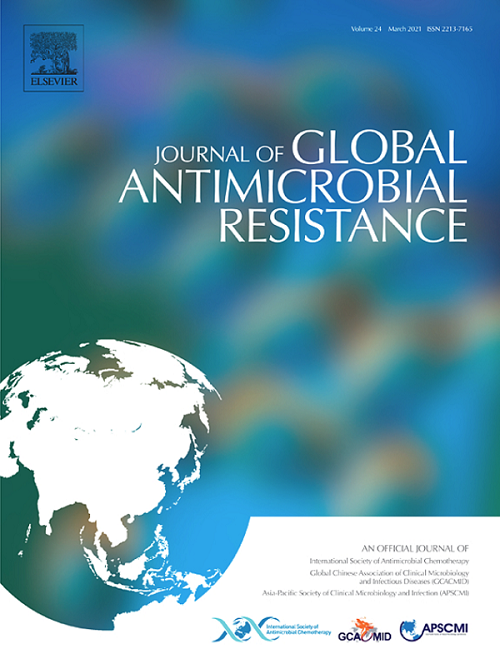为实现“同一个健康”搭建桥梁——在英格兰开展为期两年的抗微生物药物耐药性纵向研究,采用临床和基于废水的监测方法。
IF 3.2
3区 医学
Q2 INFECTIOUS DISEASES
引用次数: 0
摘要
目的:COVID-19大流行影响了临床环境中的抗菌素耐药性(AMR),但缺乏证据。考虑到这一点,我们利用基于废水的流行病学(WBE)评估了COVID-19阴影下的社区AMR。方法:在2020年4月至2022年3月期间,从英格兰四个不同社区收集590份废水样本,检测抗生素使用情况、其代谢物和持续抗生素耐药基因(ARGs)。利用WBE数据对流域范围内的COVID-19病例和抗生素处方数据进行三角化,以精细时空分辨率评估COVID-19大流行对抗生素使用变化和由此产生的AMR的影响。结果:在COVID大流行期间(特别是在封锁期间),抗生素消费量和抗菌素耐药性患病率的下降可能是由于社会互动减少,而不是由于抗生素处方减少。与前一个大流行年份相比,2021- 2022年人口正常化日摄入量和日处方分别增加了17.2%和5.8%。在17种抗生素中,阿莫西林和克拉霉素在2020-21年间明显受到COVID-19限制的影响,平均使用量分别下降31.5% (p < 0.01)和13.5% (p < 0.05),其次在2021-22年间增加。这对目前侧重于减少抗生素作为抗生素耐药性的关键风险因素的实践和政策具有重大意义。结论:需要更好、更全面的战略,包括“一个健康”理念,以理解和应对抗菌素耐药性挑战。本文章由计算机程序翻译,如有差异,请以英文原文为准。
Building bridges to operationalize One Health — A longitudinal two years’ AMR study in England using clinical and wastewater-based surveillance approaches
Objectives
The coronavirus disease 2019 (COVID-19) pandemic impacted antimicrobial resistance (AMR) in clinical settings, but evidence is lacking. Considering this, we evaluated community-wide AMR in the shadow of COVID-19, using wastewater-based epidemiology (WBE).
Methods
Five hundred ninety wastewater samples were collected from 4 contrasting communities in England between April 2020 and March 2022 to test for antibiotics used, their metabolites, and persistent antibiotic resistance genes (ARGs). Catchment-wide COVID-19 cases and antibiotic prescription data were triangulated with WBE data to evaluate the impact of the COVID-19 pandemic on changes in antibiotic use and resulting AMR at fine spatio-temporal resolution.
Results
Observed reduction in antibiotic consumption and AMR prevalence during the COVID-19 pandemic (especially during lockdowns) is likely due to reduced social interactions rather than due to reduced antibiotic prescribing. Population-normalised daily intake and daily prescriptions showed an increase of 17.2% and 5.8%, respectively, in 2021 to 2022, in comparison to the previous pandemic year. Of the 17 antibiotics targeted, amoxicillin and clarithromycin were clearly affected by COVID-19 restrictions during the years 2020 to 2021 with an average of 31.5% (P < 0.01) and 13.5% (P < 0.05) lower usage, respectively, followed by an increase in 2021 to 2022. This has significant implications for practice and policy that currently focus on the reduction of antibiotics as the key risk factor in AMR.
Conclusions
Better, more holistic strategies encompassing the One Health philosophy are needed to understand and act upon the AMR challenge.
求助全文
通过发布文献求助,成功后即可免费获取论文全文。
去求助
来源期刊

Journal of global antimicrobial resistance
INFECTIOUS DISEASES-PHARMACOLOGY & PHARMACY
CiteScore
8.70
自引率
2.20%
发文量
285
审稿时长
34 weeks
期刊介绍:
The Journal of Global Antimicrobial Resistance (JGAR) is a quarterly online journal run by an international Editorial Board that focuses on the global spread of antibiotic-resistant microbes.
JGAR is a dedicated journal for all professionals working in research, health care, the environment and animal infection control, aiming to track the resistance threat worldwide and provides a single voice devoted to antimicrobial resistance (AMR).
Featuring peer-reviewed and up to date research articles, reviews, short notes and hot topics JGAR covers the key topics related to antibacterial, antiviral, antifungal and antiparasitic resistance.
 求助内容:
求助内容: 应助结果提醒方式:
应助结果提醒方式:


